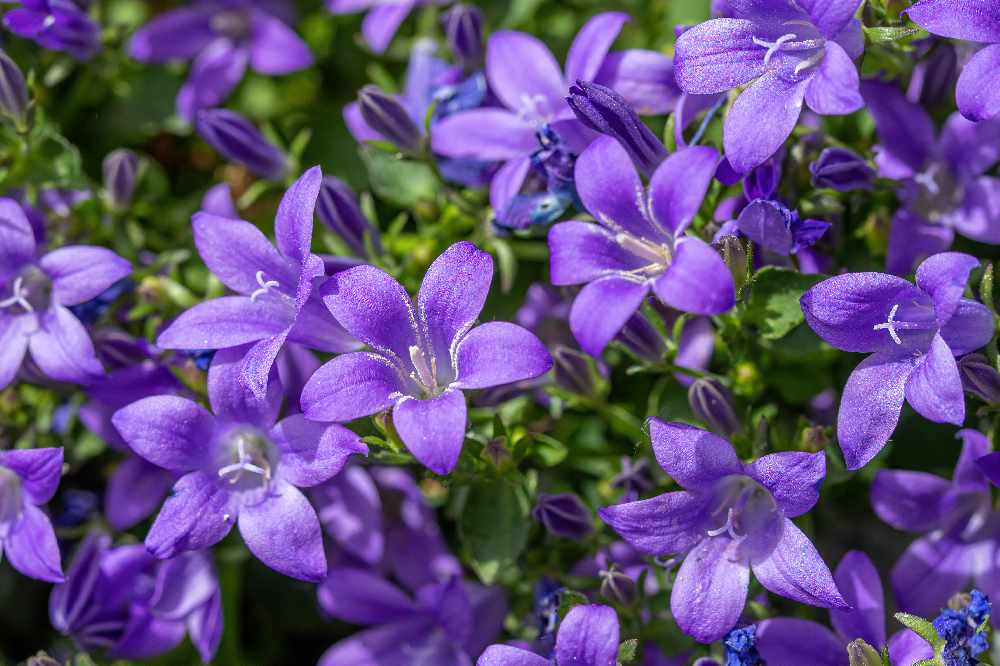
Plant Heritage, a leading horticultural conservation charity, is calling for Islanders to help save ten different plant groups at risk of being lost from our gardens.
Anyone with a passion for plants, or whose interest in gardening or caring for houseplants was sparked during 2020’s lockdowns, is being asked to consider looking after a specific plant group as part of Plant Heritage’s annual ‘Missing Genera’ campaign.
Each year the Missing Genera showcases different plant groups that aren’t cared for as part of a ‘National Plant Collection’.
If plants aren’t being actively conserved in these collections, they are at risk of disappearing from cultivation.
Since the campaign began in 2016, the Missing Genera has resulted in eight new National Plant Collections conserving over 650 species and cultivars, including Alcea (Hollyhocks) and Aeonium, and there are many more in the process of building up their collection.
Two plant groups on the 2021 Missing Genera: Campanula 'Samantha' (L) and Zantedeschia ‘Zazu’
This year, the ten plant varieties in need of a home are:
- Campanula: Also known as bellflowers, these distinctive open, bell-shaped flowers come in shades blue, pink, purple and white, and range from creeping alpine plants to tall border favourites. There are about 80 species and a staggering 232 cultivars available, but it would be possible to look after a subset to avoid collecting them all!
- Erigeron: Related to daisies, Erigeron can be annuals, biennials or perennial. They thrive in sunny spots with some happily growing through the cracks in paving. There are 30 cultivars currently available in the UK, with many more to be found worldwide.
- Lysimachia: From creeping, ground cover plants to stately perennials, this genus can survive in a variety of settings. The UK native species have yellow flowers, but the garden types include whites and deep maroons.
- Papaver (Oriental Group): These pretty perennial poppies are a stalwart of early summer. Since the 19th century oriental poppies have been bred to produce a range of coloured flowers, from pastel shades to deep plums, in addition to their original red.
- Phormium: Also called New Zealand flax, this vigorous, easy to grow plant looks good all year round. Good for windy or coastal sites, the long, strap-like leaves vary from deep purples to reds and yellows, and can also be striped. There are about 60 cultivars available.
- Phygelius: These are low growing evergreen shrubs but are often treated as perennials. The tubular flowers are held on long stems and come in stunning tones of pink, red and occasionally yellow, and will last from mid-summer into the autumn.
- Pittosporum: The glossy, evergreen leaves are the standout feature of these shrubs or small trees, which can be used for hedging, ground cover or as specimen plants. The small flowers can be scented and are produced in late spring to early summer.
- Sansevieria: These make popular houseplants due to their tolerance for low light. Also known as ‘mother-in-law’s tongues’, the upright, leathery leaves come in many patterns of variegation.
- Silene: Some Silene are familiar wildflowers, also known as ‘campions’ or ‘catchflys’. There are many other species to be found in the UK, from alpines to border perennials. The colour palette of Silene ranges from pinks, lilacs, whites and reds, and they flower from late spring through early summer.
- Zantedeschia: Commonly called arum lilies, these hardy, outdoor plant tends to have white flowers and thrive in damp places. There are also more tender forms that come in a range of colours. There are about 70 cultivars available of these dramatic plants in the UK.
Vicki Cooke, Conservation Manager at Plant Heritage said:
“Starting a National Plant Collection doesn’t have to be daunting – in fact, we have several that are cared for in homes, conservatories and gardens! Anyone can help, and by caring for a plant group means that future generations can enjoy them as much as we do now.
"What matters is that the interest and love for saving a plant is there, so we really hope the ten plants on this year’s Missing Genera list find their future Collection Holder soon.”
To find out more about the Missing Genera, visit: https://www.plantheritage.org.uk/national-plant-collections/missing-genera/ and to find out how to start a National Plant Collection of one of the above plant groups, visit: https://www.plantheritage.org.uk/national-plant-collections/start-a-national-plant-collection
To find out more about Plant Heritage, its National Plant Collections or for information about how to become a Collection Holder, Plant Guardian, National Collection Sponsor or member, visit www.plantheritage.org.uk .

 Isle Of Wight Council To Move To Committee System In 2025
Isle Of Wight Council To Move To Committee System In 2025
 Highway Improvement At Church Litten Next Week
Highway Improvement At Church Litten Next Week
 Man Arrested After Being Caught During Act Of Self-Gratification In Newport
Man Arrested After Being Caught During Act Of Self-Gratification In Newport
 May Day Bank Holiday Recycling And Waste Collection Information
May Day Bank Holiday Recycling And Waste Collection Information
 Isle Of Wight Ambulance Service Star Louise Awarded King’s Ambulance Medal
Isle Of Wight Ambulance Service Star Louise Awarded King’s Ambulance Medal
 Stranded RIB Towed To Safety By Cowes Lifeboat
Stranded RIB Towed To Safety By Cowes Lifeboat
 Major Highway Works Taking Place Across Isle Of Wight This Month
Major Highway Works Taking Place Across Isle Of Wight This Month
 Three Men Arrested On Suspicion Of 'Attempting To Take Child'
Three Men Arrested On Suspicion Of 'Attempting To Take Child'
 Wildheart Animal Sanctuary Rescue To Bring First Bears To Isle Of Wight For 30 Years
Wildheart Animal Sanctuary Rescue To Bring First Bears To Isle Of Wight For 30 Years
 One Week To Go Until Isle Of Wight Walking Festival 25th Anniversary
One Week To Go Until Isle Of Wight Walking Festival 25th Anniversary
 Apply Now For Grant Funding To Help Strengthen Family Support On Isle Of Wight
Apply Now For Grant Funding To Help Strengthen Family Support On Isle Of Wight
 Pavers Shoes The Latest Newport Business To Close Its Doors
Pavers Shoes The Latest Newport Business To Close Its Doors
 Isle Of Wight Libraries Celebrate World Book Night
Isle Of Wight Libraries Celebrate World Book Night
 Traffic Advice Issued For Walk The Wight
Traffic Advice Issued For Walk The Wight
 Hovertravel's Hoverbus Showcases All-New Look
Hovertravel's Hoverbus Showcases All-New Look
 Bear Grylls Pays Homage To Young Islander Ginny Following Ultimate Scouting Award
Bear Grylls Pays Homage To Young Islander Ginny Following Ultimate Scouting Award
 Southern Vectis To Open May Community Fund For Worthy Causes Across Isle Of Wight
Southern Vectis To Open May Community Fund For Worthy Causes Across Isle Of Wight
 Terrorism Plot Teen From Isle Of Wight Further Sentenced
Terrorism Plot Teen From Isle Of Wight Further Sentenced
 Ryde's Waterside Pool Secures £254,000 Of Government Refurbishment Funding
Ryde's Waterside Pool Secures £254,000 Of Government Refurbishment Funding
 Flood Warnings Eased But More 'Unsettled' Weather On The Way
Flood Warnings Eased But More 'Unsettled' Weather On The Way


